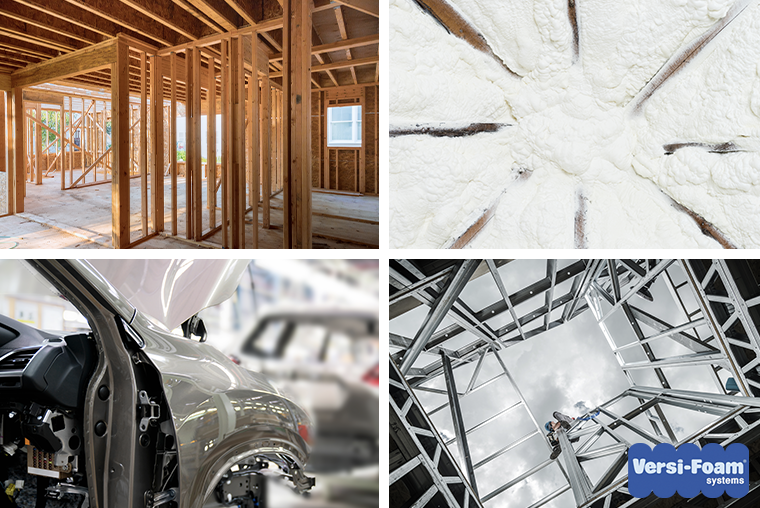Versi-Foam® spray foam insulation comes in four different product formulas: closed cell, open cell, slow rise, and high density. Each formula has been developed for certain specific applications and has its own unique uses. If you’ve ever asked yourself, “Which spray foam insulation should I use in my situation?”, this blog was written for you.
When should I use closed cell spray foam?
Closed cell spray foam is uniquely designed for times when a water, vapor, or air barrier is needed. It’s also the best choice when energy efficiency is high priority because of its greater r-value.
In addition, it adds strength to walls. However, it should not be sprayed into the enclosed cavity between the exterior wall and drywall. Rather, it can be sprayed between the exterior wall and the drywall if it’s done before the drywall is put up.
Closed cell spray foam is the right insulation choice in the following circumstances:
- Basements and crawl spaces
- New construction and remodeling
- Commercial and industrial buildings
- Tiny homes (because of its lower expansion rate)
- Outbuildings such as sheds and pole barns
When should I use open cell spray foam?
Open cell spray foam is best used in residential applications because of its cost effectiveness and sound dampening capabilities. It is a thicker, softer material and can completely fill the area between the studs, inhibiting the transfer of sound between rooms.
It’s especially well suited for unvented attic applications and sealing the underside of roof decks. It doesn’t provide a water barrier and so is not a good choice in places where dampness is a problem, such as basements and locations with high humidity. Consider open cell spray foam insulation for the following projects:
- Attic insulation
- Home and garage roof decks
- Residential insulation in milder climates
- Any project where small openings need to be sealed
When should I use slow rise spray foam?
Slow rise spray foam is a closed cell foam that becomes tack-free in about three minutes, instead of the 30-45 seconds for standard spray foam. This makes it perfect for insulating closed cavities, blind cavities and difficult to reach voids where the foam needs extra time to completely fill the area. Choose slow rise spray foam to insulate:
- Boats and other marine vehicles
- Existing homes and buildings
- Remodels
- Vehicles and trailers
When should I use high density spray foam?
High density spray foam is a closed cell foam with a density of 2.8 lbs. per cubic foot, compared to 2 lbs per cubic foot in standard closed cell spray foam. It’s used in projects where a higher r-value is needed to lower energy costs for the lifetime of the building. It also provides extra strength and load support to a structure. In fact, it’s often called “roofing foam” because it’s used on the exterior of flat roof buildings and can reduce wind damage to the roof. Choose high density spray foam for:
- Exterior applications
- Roofing applications
- Flat roof commercial and industrial buildings
- Metal building roofs
- The exterior of cryogenic tanks of space vehicles
Spray foam insulation is incredibly versatile and is recommended by construction professionals for its energy efficiency and long life. If your project isn’t on this list, please call us to talk more about your specific needs. (800) 657-0702





